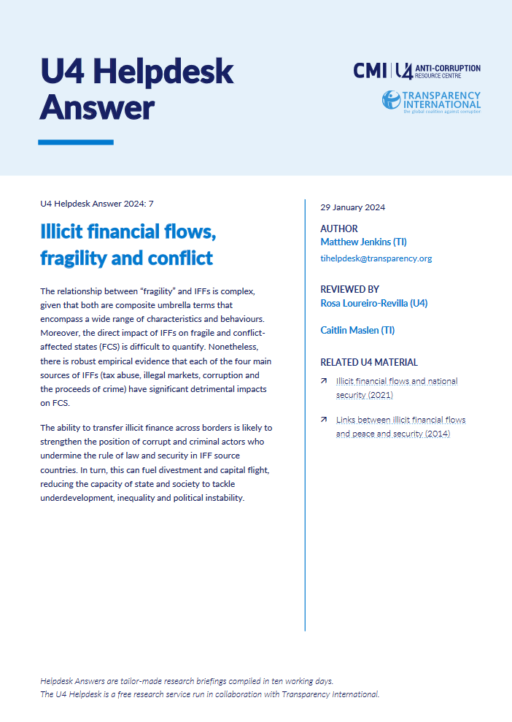
This Anti-Corruption Helpdesk brief was produced in response to a query from a U4 Partner Agency. The U4 Helpdesk is operated by Transparency International in collaboration with the U4 Anti-Corruption Resource Centre based at the Chr. Michelsen Institute.
Query
Please summarise the evidence on the links between global flows of illicit finance and fragility and conflict.
Summary
The relationship between “fragility” and IFFs is complex, given that both are composite umbrella terms that encompass a wide range of characteristics and behaviours. Moreover, the direct impact of IFFs on fragile and conflict-affected states (FCS) is difficult to quantify. Nonetheless, there is robust empirical evidence that each of the four main sources of IFFs (tax abuse, illegal markets, corruption and the proceeds of crime) have significant detrimental impacts on FCS.
The ability to transfer illicit finance across borders is likely to strengthen the position of corrupt and criminal actors who undermine the rule of law and security in IFF source countries. In turn, this can fuel divestment and capital flight, reducing the capacity of state and society to tackle underdevelopment, inequality and political instability.
Main points
- In financial terms, economists concur that IFFs inhibit domestic capital accumulation, reduce productivity, discourage investment, and erode government revenue (UNCTAD 2020b: 129; Herkenrath 2014; IMF 2023b).
- These effects deprive countries of much-needed funds that could fund the provision of social welfare and spur the kind of economic growth that could help societies escape the “fragility trap” (Slany, Cherel-Robson, and Picard 2020: 35; Commission on State Fragility 2018).
- Research has found, for instance, that states with high levels of capital flight spend an average of 25% less on health and 58% less on education than countries with low levels of capital flight (UNCTAD 2020b: 152).
- Yet IFFs have negative ramifications beyond the economic sphere, undermining the quality of political institutions, reducing social cohesion, increasing inequality, accelerating environmental degradation and fuelling armed conflicts (Cobham and Janský 2017; Moore 2012; Herkenrath 2014).
- In so doing, IFFs exacerbate drivers of fragility that, in turn, create conditions conducive to further illicit outflows, indicating a mutually-reinforcing “circular relationship between IFFs, development-inhibiting economic policy environments and weak political institutions” (Herkenrath 2014).
Contents
- Background
- Definitions
- Characteristics of FCS
- Measuring IFFs from FCS
- Fragility and IFFs: a vicious cycle
- The macroeconomic impacts of IFFs on FCS
- Broader impacts of IFFs on FCS
- Governance
- Societal
- Environmental
- Economic
- Physical
- Spotlight on financial centres
- References
Caveat
Fragility has increasingly come to be viewed as a complex multidimensional phenomenon (OECD 2022), which poses urgent and unique challenges to sustainable development (German Federal Ministry for Economic Cooperation and Development 2019). However, while there exists an expansive literature on the role of corruption in generating and sustaining fragility, there are fewer studies on how illicit financial flows (IFFs) relate to “fragility”.
Much of the literature on fragile and conflict-affected states (FCS) (Green 2017; Kaplan 2008; Commission on State Fragility 2018; IMF 2022) has little to say about the role of financial flows, whether licit or illicit. On the other hand, while some studies of IFFs do examine the negative impact on low and middle-income countries (LMICs) (Cobham and Janský 2018; Brandt 2023), they do not tend to consider the effects on FCS in isolation from the wider group of developing countries.
An additional issue relates to “the amorphous nature of IFFs, both in their definition and in their measurement” (Collin 2020: 2). The term IFFs encompasses a wide range of phenomena and behaviour, from cross-border money laundering to tax avoidance. This has led to calls to “disaggregate” IFFs (Reuter 2017) by unpacking the concept to explore in greater detail the various drivers and consequences of specific illicit economies, be that gold smuggling networks, tax evasion schemes or the movement of the proceeds of corruption (OECD 2018a).
This Helpdesk Answer attempts to synthesise the evidence on how IFFs relate to fragility. Yet the breadth of both concepts implies that practitioners and policymakers need to consider the precise links between specific dimensions of these two phenomena at a more granular level. For instance, by exploring the connection in given locations between narcotics trafficking and security, corruption and political legitimacy or multinational profit shifting and economic inequality.
Authors
Matthew Jenkins (TI,[email protected]
Reviewers
Rosa Loureiro-Revilla (U4) and Caitlin Maslen (TI)
Date
01/03/2024
Tags
 Download PDF
Download PDF
